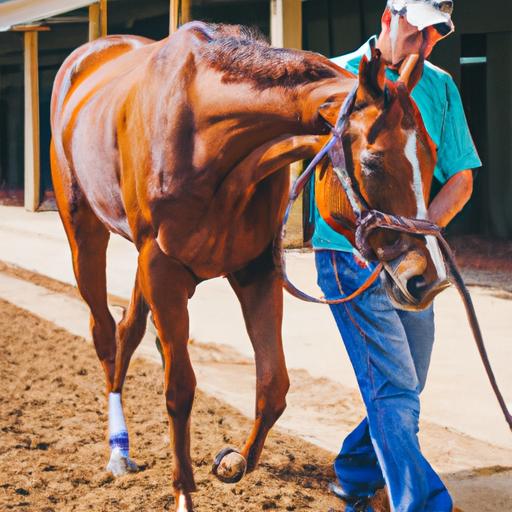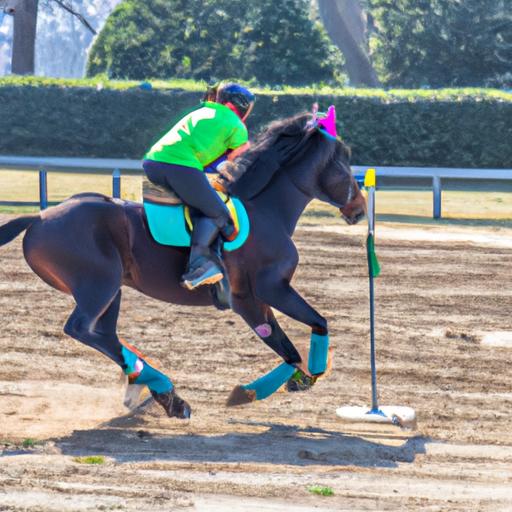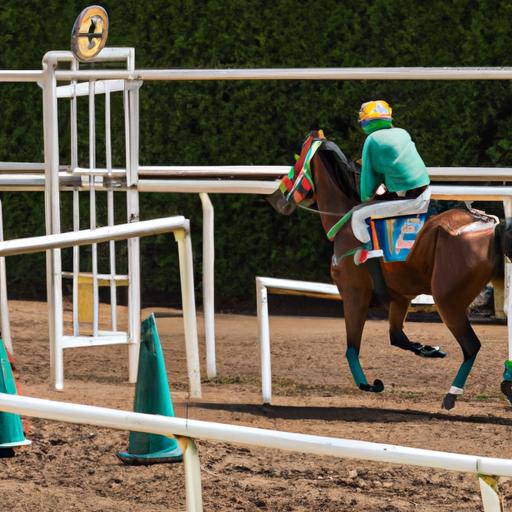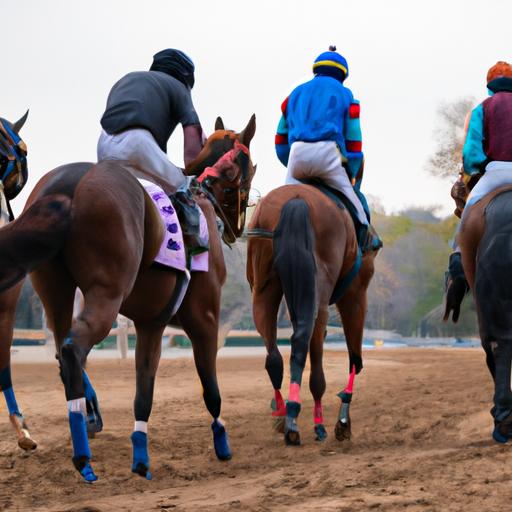Unveiling the Secrets of kentucky derby horse training: Discover the rigorous techniques and skilled trainers behind Derby glory. A must-read for race enthusiasts!
Welcome to Horsemasterypro.com! Today, I invite you to embark on an exhilarating journey into the world of horse racing as we delve into the art of Kentucky Derby horse training. As the most prestigious event in American horse racing, the Kentucky Derby captivates millions of spectators each year. But have you ever wondered what it takes to prepare these majestic creatures for the ultimate test of speed and endurance? In this article, we uncover the secrets behind the scenes and explore the significance of horse training in the quest for Derby glory.
Introduction – Unveiling the Grandeur of the Kentucky Derby

Before we dive into the captivating realm of horse training, let’s take a moment to understand the essence of the Kentucky Derby. Dubbed as “The Most Exciting Two Minutes in Sports,” this iconic race has been captivating hearts since 1875. The Derby is not just a horse race; it’s a reflection of tradition, skill, and sheer determination.
As the first leg of the revered Triple Crown series, the Kentucky Derby serves as a battleground for the finest thoroughbreds in the world. The allure of the Derby lies not only in its rich history but also in the dreams it ignites in the hearts of owners, trainers, jockeys, and spectators alike. It’s a celebration of equine athleticism, where extraordinary horses compete for eternal glory.
The Crucial Role of Horse Training in Kentucky Derby Preparation

Now, let’s shift our focus to the cornerstone of success in the Kentucky Derby: horse training. Behind every exhilarating race, there’s an arduous training regimen that shapes these magnificent creatures into champions. Horse training is not merely about building physical strength but also about nurturing mental fortitude and honing race-specific skills.
To emerge victorious on Derby day, horses must undergo a comprehensive training program that encompasses physical fitness, mental preparation, proper nutrition, and injury prevention. Each aspect contributes to the overall development of the horse, ensuring they are primed to unleash their full potential on the track.
As the countdown to the Kentucky Derby begins, trainers devise tailored training techniques to prepare their horses for the grueling challenge ahead. These techniques include building endurance and stamina through long-distance gallops and interval training, enhancing speed and agility through sprint workouts and hill training, and developing race-specific skills such as gate training, track simulations, and practicing race strategies.
Stay tuned as we unravel the intricacies of Kentucky Derby horse training, exploring the techniques, challenges, and the irreplaceable role of skilled trainers in shaping these magnificent athletes. The path to Derby triumph is not for the faint-hearted, but with the right training, dedication, and a touch of destiny, it can lead to immortality in the annals of horse racing history.
So, saddle up and join me on this captivating journey into the world of Kentucky Derby horse training. Together, we’ll unlock the secrets behind the success of these extraordinary equine athletes.
Understanding the Kentucky Derby Horse Training Process

A Brief History: Evolution of Horse Training for the Kentucky Derby
The training techniques employed in preparing horses for the Kentucky Derby have evolved significantly since the inaugural race in 1875. Initially, horse training focused primarily on physical conditioning and stamina-building exercises. However, as the sport advanced, trainers began to realize the importance of a holistic approach, encompassing both physical and mental aspects of training.
Key Factors in Kentucky Derby Horse Training
Successful Kentucky Derby horse training requires a meticulous understanding of key factors that contribute to a horse’s peak performance. Let’s explore some essential elements trainers consider when preparing their equine athletes for the Derby:
1. Physical Fitness and Conditioning
Physical fitness forms the foundation of a champion racehorse. Trainers employ a combination of cardiovascular exercises, strength training, and endurance-building workouts to enhance their horse’s overall fitness. Long gallops, timed runs, and interval training methods are common techniques utilized to improve endurance and stamina.
2. Mental Preparation and Focus
The Kentucky Derby is not only a test of physical prowess but also a mental challenge. Horses must possess the mental fortitude to handle the pressure of the race and maintain focus amidst the roaring crowd. Trainers employ various techniques, such as exposure to race day environments, sensory training, and desensitization exercises, to help horses remain calm and composed.
3. Nutrition and Diet
Proper nutrition plays a vital role in maintaining a horse’s overall health and performance. Trainers work closely with equine nutritionists to devise well-balanced diets that meet the specific needs of each horse. A combination of high-quality forage, balanced grains, and appropriate supplements ensures optimal nutrition and energy levels.
4. Regular Exercise and Workouts
Consistent exercise and structured workouts are crucial in developing a race-ready horse. Trainers carefully plan a training schedule, incorporating a mix of gallops, sprints, and hill workouts to improve speed, agility, and strength. These exercises also aid in building muscle tone and conditioning the horse’s body for the demands of the race.
5. Injury Prevention and Management
Injuries can derail a horse’s Derby dreams, making injury prevention a top priority for trainers. They implement measures such as proper warm-up and cool-down routines, regular veterinary check-ups, and closely monitoring the horse’s overall well-being. Should an injury occur, trainers work alongside veterinarians to implement effective rehabilitation programs and manage the horse’s recovery.
By considering these key factors, trainers ensure that their horses are primed for success on Kentucky Derby day. In the next section, we will delve deeper into the specific training techniques employed to build endurance, enhance speed, and develop race-specific skills. So, let’s continue our exploration into the fascinating world of Kentucky Derby horse training!
Unleashing the Power: Training Techniques for Kentucky Derby Horses
As we delve deeper into the realm of Kentucky Derby horse training, it’s time to uncover the training techniques that transform these magnificent creatures into racing powerhouses. Every aspect of their preparation is meticulously designed to enhance their endurance, speed, agility, and race-specific skills. Let’s explore the key training techniques that pave the way to Derby glory.
A. Building Endurance and Stamina: The Foundation of Success
-
Long Distance Gallops and Runs: Endurance is the bedrock of success in the Kentucky Derby. Trainers incorporate long-distance gallops and runs into their horses’ training routines to build the necessary stamina for the demanding 1.25-mile race. These extended workouts gradually increase the horse’s cardiovascular capacity and endurance, preparing them for the relentless pace of the Derby.
-
Interval Training Methods: In addition to long-distance runs, trainers employ interval training methods to optimize the horse’s fitness levels. By alternating between bursts of intense speed and periods of recovery, interval training enhances cardiovascular performance, improves muscle efficiency, and boosts overall stamina. This rigorous training ensures that Derby contenders are primed to give their best until the finish line.
B. Enhancing Speed and Agility: Unleashing the Need for Velocity
-
Sprint Workouts: Speed is a crucial asset in the Kentucky Derby, and trainers employ sprint workouts to unleash the horse’s potential for explosive bursts of acceleration. These short, high-intensity exercises help develop the horse’s fast-twitch muscle fibers, increasing their ability to generate rapid speed. By incorporating timed sprints into their training regimen, trainers aim to enhance the horse’s overall quickness and agility.
-
Hill Training: To elevate a horse’s agility and power, trainers often incorporate hill training into their routine. By galloping uphill, horses engage their hindquarters, developing the necessary strength to propel themselves forward with greater force. This uphill challenge not only improves the horse’s speed but also enhances their balance and coordination, vital for navigating the twists and turns of the Derby track.
C. Developing Race-Specific Skills: Mastering the Art of Competition
-
Gate Training: The starting gate can make or break a horse’s chances in the Kentucky Derby. Trainers focus on gate training to acclimate horses to the confined space and prepare them for a clean, efficient start. By repeatedly practicing entering and exiting the gate, horses become familiar with the procedure, minimizing the risk of a sluggish start that could jeopardize their chances of success.
-
Track Simulations: To simulate the intensity of race day, trainers create track simulations that mimic the Derby experience. These simulations involve timed workouts at race pace, allowing horses to become accustomed to the speed and intensity they will face in the actual race. By exposing horses to race-like conditions, trainers ensure they are mentally and physically prepared for the adrenaline-fueled atmosphere of the Kentucky Derby.
-
Practicing Race Strategies: Alongside physical conditioning, trainers focus on honing race strategies during training sessions. Horses learn to respond to jockey cues, maneuver through traffic, and maintain optimal positioning throughout the race. By practicing various race scenarios, trainers equip horses with the tactical skills needed to make split-second decisions, giving them a competitive edge on Derby day.
With these training techniques, trainers sculpt Kentucky Derby horses into finely tuned athletes, ready to showcase their immense talent and determination on the grandest stage of horse racing. Join us in the next section as we explore the irreplaceable role of skilled trainers in shaping these magnificent athletes.
The Indispensable Role of Skilled Trainers in Kentucky Derby Horse Training
A. Unveiling the Role of Trainers in Preparing Horses for the Kentucky Derby
When it comes to Kentucky Derby horse training, the role of a skilled trainer cannot be overstated. Trainers are the unsung heroes behind the scenes, working tirelessly to shape raw talent into Derby contenders. They are the guiding force, the architects of success, and the confidants of these majestic athletes.
Trainers play a multifaceted role in preparing horses for the Kentucky Derby. They meticulously design training programs tailored to the unique needs of each horse, focusing on building physical strength, refining technique, and cultivating mental resilience. From monitoring daily workouts to overseeing nutrition and healthcare, trainers leave no stone unturned in their pursuit of Derby greatness.
B. Selecting the Right Trainer for Optimal Results
Choosing the right trainer is paramount in the quest for optimal results. A skilled trainer possesses a deep understanding of equine physiology, psychology, and the nuances of racehorse training. They possess an innate ability to connect with their horses, forging a bond built on trust and respect.
When selecting a trainer for your Derby hopeful, consider their track record, experience, and reputation within the industry. Look for trainers who have consistently produced successful horses and have a thorough knowledge of the intricacies of the Kentucky Derby. Beyond expertise, it’s crucial to find a trainer whose training philosophy aligns with your goals and values.
C. Examples of Renowned Trainers and Their Successful Track Records
Throughout the history of the Kentucky Derby, several trainers have left an indelible mark on the sport with their exceptional training abilities. These individuals have consistently showcased their expertise in preparing horses for the Derby, solidifying their names as legends in the racing world.
One such example is Bob Baffert, a renowned trainer known for his impressive track record in the Kentucky Derby. With a total of six Kentucky Derby victories to his name, Baffert has proven time and again his ability to guide horses to triumph on the biggest stage. His training methods and attention to detail have become synonymous with success in the Derby.
Another notable trainer is D. Wayne Lukas, a veteran in the industry. Lukas has trained four Kentucky Derby winners and is widely respected for his innovative training techniques and dedication to his craft. His ability to instill discipline and mental fortitude in his horses has consistently propelled them to peak performance on Derby day.
These trainers, among many others, serve as shining examples of the indispensable role skilled trainers play in Kentucky Derby horse training. Their expertise, knowledge, and unwavering commitment to their craft elevate their horses to the pinnacle of success.
Challenges and Risks in Kentucky Derby Horse Training
Training a horse for the Kentucky Derby is no easy feat. Along the journey to Derby glory, trainers and horses encounter numerous challenges and risks that test their resilience. In this section, we explore some of the hurdles they face and the strategies employed to overcome them.
Dealing with injuries and setbacks
Injuries and setbacks are an unfortunate reality in the world of horse racing. The demanding training regimen and intense competition increase the risk of injuries, which can jeopardize a horse’s chances of participating in the Kentucky Derby. Trainers must carefully monitor their horses’ health, employ preventive measures, and respond promptly to any signs of discomfort or injury. Collaborating with skilled veterinarians and equine specialists, trainers create comprehensive rehabilitation plans to ensure the horses’ well-being and a swift recovery.
Addressing psychological factors and stress
Just like humans, horses can experience psychological factors and stress. The pressure to perform at their peak, constant exposure to new environments, and the presence of large crowds can have a profound impact on their mental well-being. Trainers employ various techniques to help horses adapt and cope with these stressors. These may include introducing them to race-like scenarios, using desensitization methods, and establishing a trusting bond between horse and trainer. By nurturing their mental resilience, trainers enhance the horses’ overall performance and increase their chances of success.
Handling the pressure of competition
The Kentucky Derby is a high-stakes race that brings immense pressure to everyone involved, including trainers, jockeys, and owners. Trainers play a pivotal role in managing the expectations and emotions surrounding the race. They must strike a delicate balance between instilling confidence in their horses and ensuring they remain focused amidst the whirlwind of excitement. By creating a supportive and structured environment, trainers help horses maintain their composure and deliver their best on the grand stage of the Kentucky Derby.
As we venture further into the realm of Kentucky Derby horse training, we must acknowledge the obstacles that trainers and horses must overcome to achieve greatness. Through their unwavering commitment and the implementation of effective strategies, they navigate the challenges, mitigate risks, and emerge stronger on the path to Derby triumph. Join me in the next section as we delve into the importance of skilled trainers in the quest for Kentucky Derby glory.


